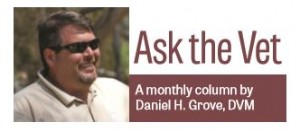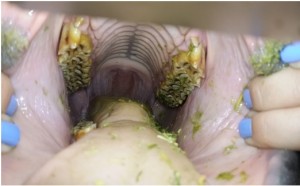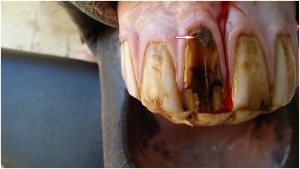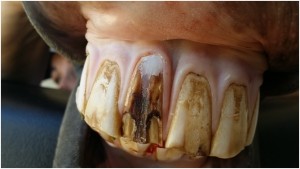 Equine dentistry has exploded over the past 10 to 15 years. When I was growing up, the veterinarian or the farrier would pull out a couple of hand floats or old rasps and grind down the sharp hooks that develop on the molars and premolars of horses’ teeth. Let’s have a look at the type of teeth horses have and why they need to be floated or filed down.
Equine dentistry has exploded over the past 10 to 15 years. When I was growing up, the veterinarian or the farrier would pull out a couple of hand floats or old rasps and grind down the sharp hooks that develop on the molars and premolars of horses’ teeth. Let’s have a look at the type of teeth horses have and why they need to be floated or filed down.
Horses have what are called hypsodont teeth. These teeth have a large “crown” or top portion of tooth that has enamel. Unlike us, where we have enamel on the outside of our crown only, horses have layers of enamel throughout the crown. This design is great for what horses are intended to eat. Horses are grazers that should be eating roughage for around eighteen hours a day. This roughage is very fibrous and can contain silica or other hard materials that are abrasive and wear down the tooth. Not only are these teeth stronger and able to take the abuse, but horses have what is termed “reserve crown”. This reserve crown is below the gum-line and continuously is erupting throughout the adult life of the horse until it runs out. Usually in their 20s or 30s, the reserve crown is exhausted, and whatever is left is what they have to work with.
Due to the normal anatomy of the equid mouth, certain parts of the teeth wear more than others. First of all, the lower jaw is slightly narrower than the upper jaw. This means that not all areas of the chewing surface of the tooth are exposed to the same amount of wear. The outer side of the molars and premolars are not flat. If you look or feel the outside of the teeth and move from the front of the mouth to the back, you will feel a bunch of what feels like speed bumps. These are a normal part of the tooth. They are what usually leads to the development of sharp points on the upper teeth along the cheeks. The same occur on the lower teeth, but because they are narrower in alignment, the points are along the tongue side of the teeth. In the first picture here, you will see a typical horse that is due for floating.

If you look closely, you can see the sharp points on the outer edges of the upper teeth. These points can dig into and/or lacerate the cheeks causing discomfort to the horse. Some people ask ,”What happens to horses in the wild?” Horses in the wild eat more fibrous feeds and a lot less grain that in captivity. Along with ingesting more gritty material, this makes the horses actually move their lower jaw more to each side, thus wearing off these areas of the tooth so that the points do not form (at least in an ideal world!).
Next we have a picture of when the teeth have been floated.

Notice how the outer edge of the upper teeth have a nice smooth bevel on them. This preserves almost all of the tooth and allows the horse to masticate or chew its food correctly.
During floating of the teeth, it gives us also a chance to thoroughly inspect the mouth. Just like with us, horses have misalignment issues. Where we can have a set of braces slapped on and move the teeth to where they should be, in horses, that is not the norm yet. We usually deal with where the teeth are and try to correct abnormalities in the teeth as they arise. Various damage or problems can develop througout the life of the horse just as with us. One of the most common problems humans experience are dental caries or “cavities”. Here is an example of the same on a horse at the end of the arrow.

The tooth has been damaged by bacteria, and it is high in the tooth so it will not wear out in the near future. I decided with the owner to repair the decayed area with a filling. You can see it in the following picture.

As you can see, the decayed material has been removed and filled with composite material, just as if it were done on you!
There are numerous reasons to have your veterinarian routinely inspect and float your horses teeth. Not only will it help your animal to masticate their food comfortably and correctly, it can help to prevent tooth loss or further damage from current problems, so they can continue to eat normally for as long as possible.
~Dan
Leave a Comment
All fields must be filled in to leave a message.